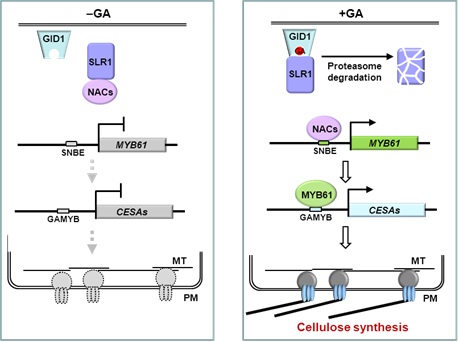Cellulose, comprised of parallel β-1,4-glucans, is a major polymer of plant cell wall. It not only represents the most abundant sustainable resource in wide use in industrial production but also plays essential roles in plant growth. The physicochemical properties of cellulose have major impacts on stem length and lodging resistance. It has long been known that cellulose synthesis in plants is tightly regulated by various phytohormones. Gibberellin (GA) is an important hormone that regulates stem height. The introduction of the semi-dwarfing genes Reduced height-1 and semi-dwarf1 into cereal crops improved crop architecture and lodging resistance, leading to a huge increase in grain yields during the 1960s. However, the genetic link between GA signaling and cellulose synthesis remains elusive. It is unclear whether GA is an upstream signal for cellulose synthesis and, if so, how plants transmit GA signals downstream to the CESA genes.
The group of Prof. ZHOU Yihua from the Institute of Genetics and Developmental Biology (IGDB), Chinese Academy of Sciences, has long-term interests in the molecular mechanisms of plant cell wall biosynthesis. In a recent study, they demonstrated that in rice (Oryza sativa), GA signals promote cellulose synthesis by relieving the interaction between SLENDER RICE1 (SLR1), a DELLA repressor of GA signaling, and NACs, the top-layer transcription factors for secondary wall formation.
They found that mutations in GA-related genes and physiological treatments altered the transcription of CELLULOSE SYNTHASE genes (CESAs) and the cellulose level. They showed that transcription factors NAC29/31 and MYB61 are CESA regulators in rice; NAC29/31 directly regulates MYB61, which in turn activates CESA expression. They provided evidence to demonstrate that this hierarchical regulation pathway is blocked by SLR1-NAC29/31 interactions. Anatomical analysis and GA content examination showed that this signaling cascade is modulated by varied endogenous GA levels and required for internode development. They also demonstrated that this signaling cascade is conservative in Arabidopsis thaliana.
These findings reveal a conserved mechanism by which GA regulates secondary wall cellulose synthesis in land plants and provide a strategy for manipulating cellulose production and plant growth.
This work has been published online in
The Plant Cell on May 22, 2015 (
doi:10.1105/tpc.15.00015), with PhD students HUANG Debao and WANG Shaogan as the co-first authors. This research was supported by the Ministry of Science and Technology of China and the National Natural Science Foundation of China.
Figure 1. Regulatory Model for Secondary Wall Cellulose Formation in Rice. A proposed signaling pathway, showing gibberellin regulation on cellulose synthesis. (Image by IGDB)
CONTACT:
ZHOU Yihua
Institute of Genetics and Developmental Biology, Chinese Academy of Sciences,
Beijing, China.
E-mail: yhzhou@genetics.ac.cn
 Figure 1. Regulatory Model for Secondary Wall Cellulose Formation in Rice. A proposed signaling pathway, showing gibberellin regulation on cellulose synthesis. (Image by IGDB)CONTACT:
Figure 1. Regulatory Model for Secondary Wall Cellulose Formation in Rice. A proposed signaling pathway, showing gibberellin regulation on cellulose synthesis. (Image by IGDB)CONTACT: CAS
CAS
 中文
中文




.png)
